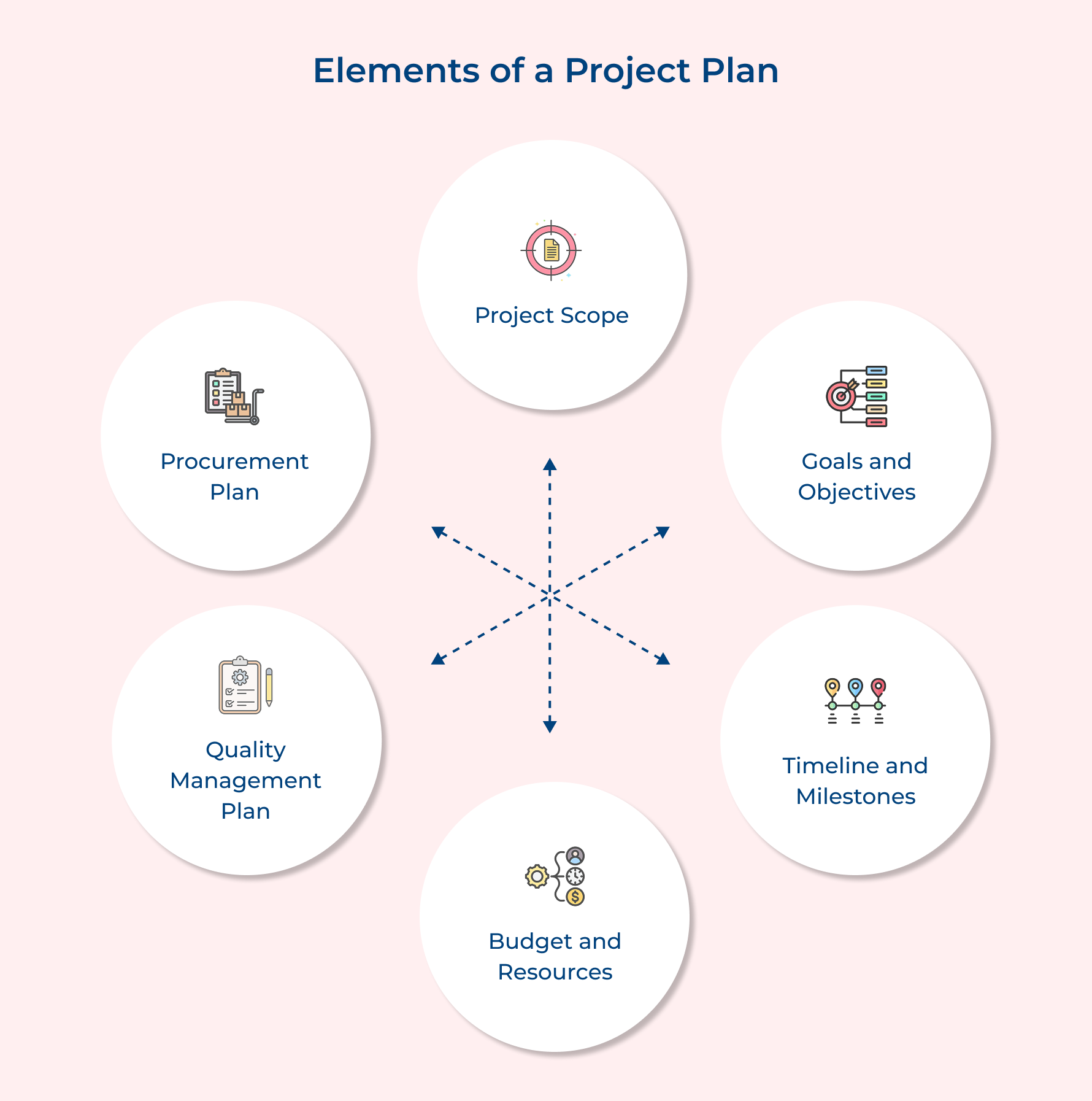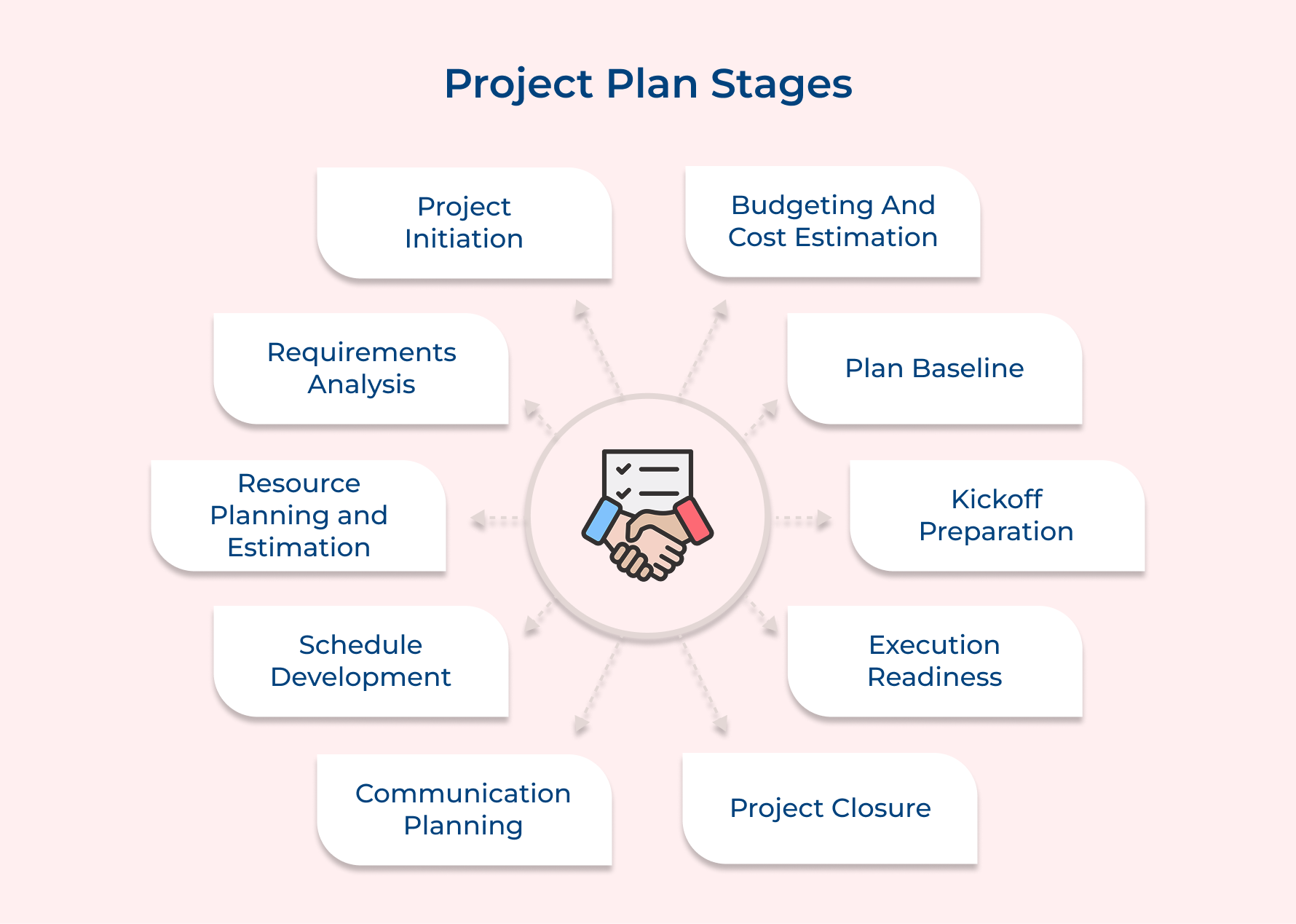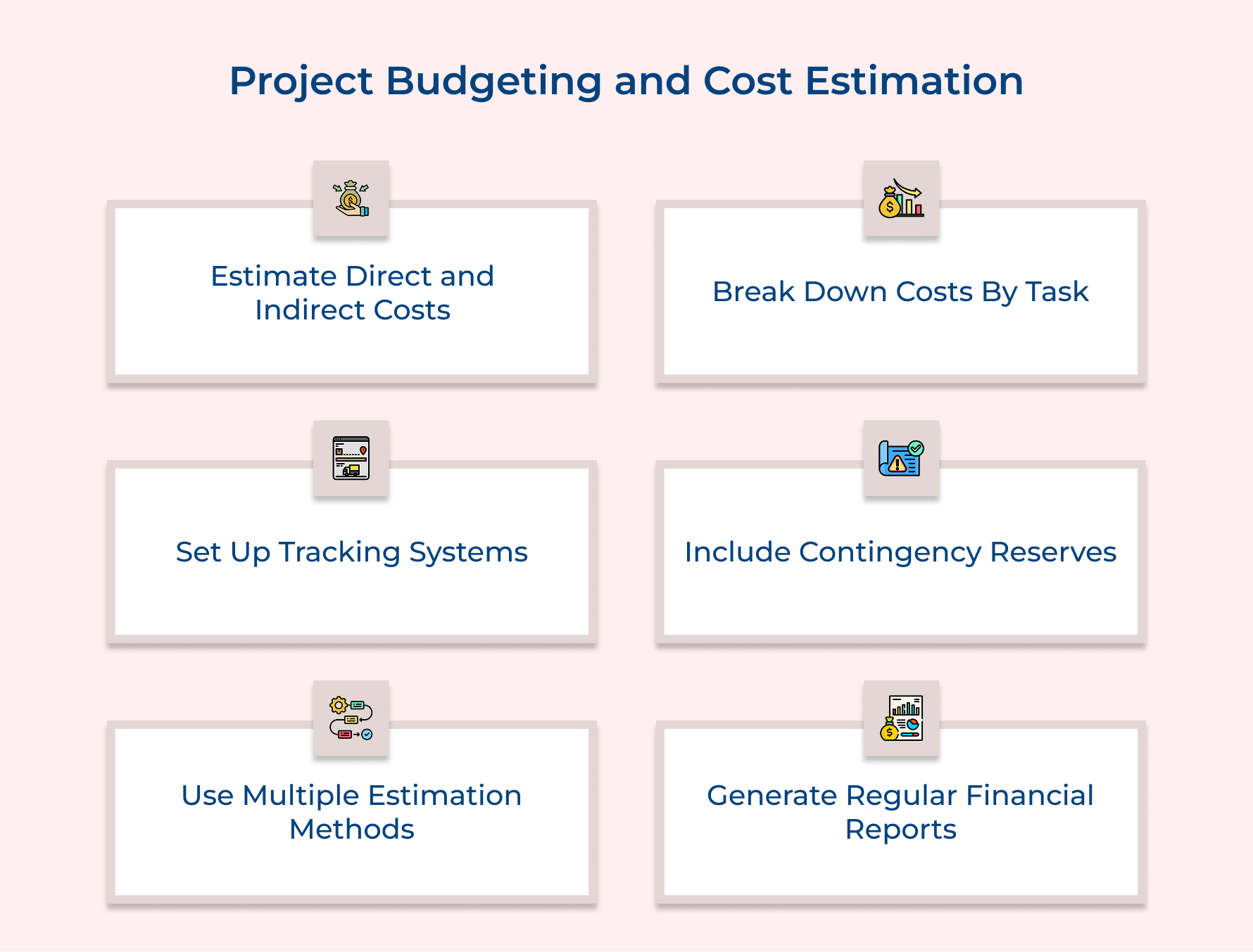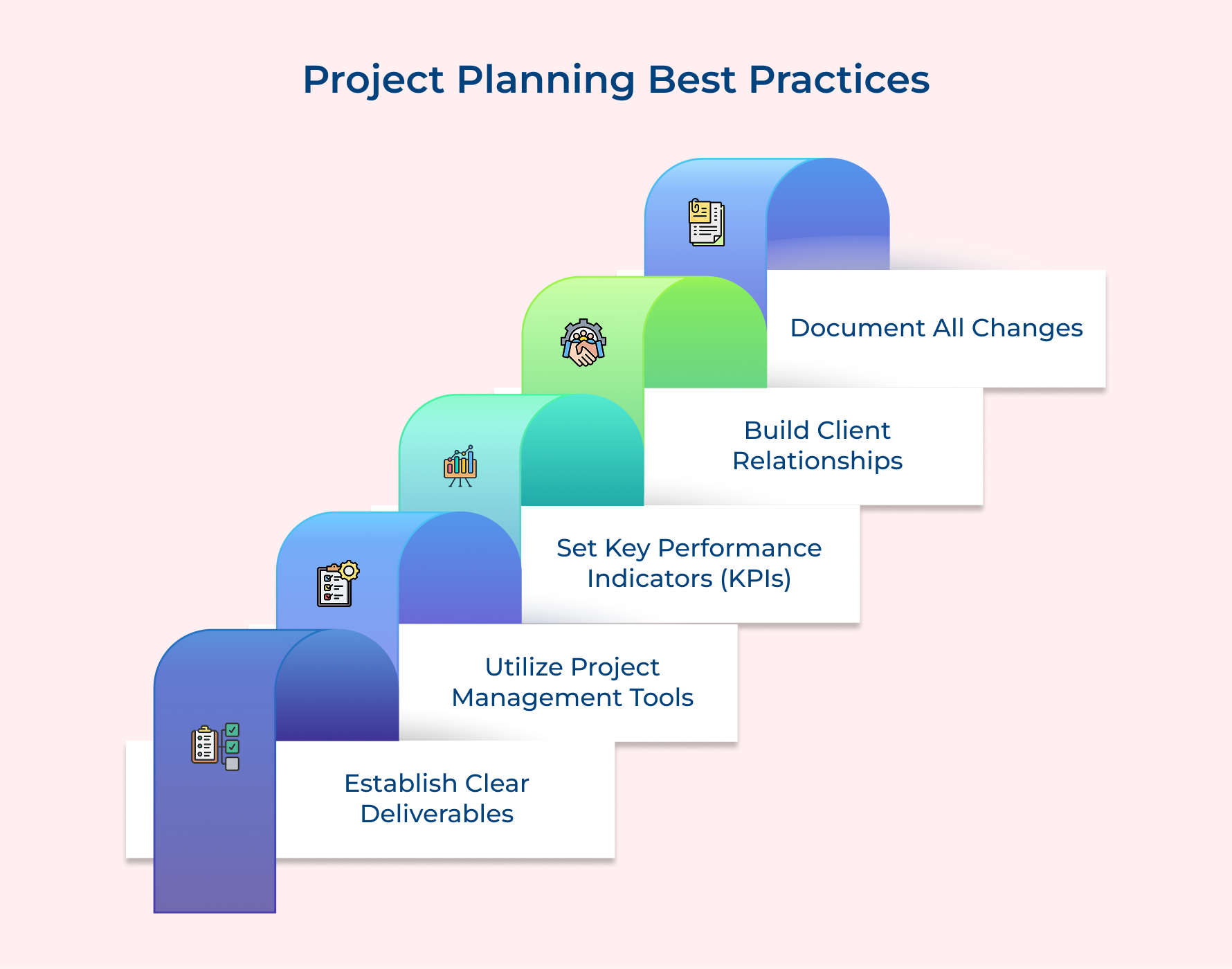Ultimate Guide to Project Planning in 10 Simple Steps

Key Highlights:
- Define specific deliverables for each project phase to manage expectations and ensure alignment with overall goals.
- Use tools like Kooper or Asana to organize tasks, track progress, and enhance team collaboration efficiently.
- Project planning is all about regular updates and clear communication with clients. It helps build trust as well as manage expectations.
Diving into a project without a detailed project plan is like setting off on a road trip without a map—you’ll likely end up lost, frustrated, and behind schedule. An unclear direction tumbles down to teams struggling to stay organized. Thus making it harder to manage tasks and keep things moving smoothly.
A well-thought-out project schedule changes everything! By setting clear goals, assigning tasks, and mapping out deadlines, teams stay focused as well as productive. Let’s explore how a solid project plan keeps chaos at bay, boosts efficiency, and sets the stage for a successful project from start to finish.
What is Project Planning?
Project planning is the process of defining the objectives, scope, resources, and schedule for a project. It involves determining the steps required to complete the project, identifying potential risks, and establishing timelines to ensure that all aspects of the project align with the desired goals.
Setting clear objectives, timelines, and resource allocations through project planning improves communication among stakeholders as well as team members. Everyone involved understands their role and the project’s goals, leading to smoother execution. Proper planning increases the chances of achieving the desired outcomes on time and within scope as part of a well-defined Project Management Plan.
Key objectives:
- Scope definition: Clearly outline project boundaries, deliverables, and requirements to prevent scope creep while ensuring focused execution.
- Resource optimization: Efficiently managing all available resources, including human capital, equipment, and budget to maximize project success.
- Risk management: Identifying potential obstacles and developing strategies to minimize their impact on project outcomes.
- Timeline management: Establishing realistic schedules and milestones to ensure timely project completion while maintaining quality standards.
Key Elements of a Project Plan
A detailed project plan ensures everything stays on track. Here are the key elements that help streamline project tasks and keep your Project Plan Example organized.
Project Scope
The project scope defines the boundaries of the project, including what will and will not be delivered. It ensures that all stakeholders have a clear understanding of the objectives and what is expected. A well-defined scope prevents scope creep as well as keeps the project on track.
Goals and Objectives
Specific, measurable, achievable, relevant, and time-bound (SMART) goals provide direction for the project. These objectives guide the project team’s efforts while setting clear targets to achieve throughout the project lifecycle.
Timeline and Milestones
A detailed schedule outlines when tasks need to be completed and includes key milestones. Breaking the project into smaller, manageable tasks with deadlines ensures that progress is tracked and keeps the team focused on meeting the project’s timeline.
Budget and Resources
The budget allocates the necessary financial resources for the project, covering costs like labor, materials, and technology. A resource plan identifies the personnel, tools, and other assets required to complete the project successfully.
Quality Management Plan
Setting quality criteria guarantees that deliverables meet agreed-upon standards. The quality management plan outlines processes for monitoring and controlling quality throughout the project.
Procurement Plan
Projects that require external resources, the procurement plan outlines how those resources will be acquired. It also includes vendor management strategies to ensure timely and cost-effective procurement.
How to Create a Project Plan: 10 Key Stages
Building an effective project plan is essential for keeping your team aligned and on track. Follow these 10 key stages to structure your plan effectively and learn how to create project plan from scratch.
Project Initiation
Every great project starts with a solid plan. Imagine you’re launching a new mobile app. Before diving into design and development, you need to define what the app does, who it’s for, and why it matters. This is where the project planning phase begins.
At this stage, the focus is on setting clear objectives, defining the project scope, and identifying key stakeholders.
Kickstart by holding stakeholder meetings to outline the project plan template—this should include the business case, objectives, and success criteria. Identify key decision-makers as well as clarify their roles in the project. Creating an initial roadmap helps visualize the journey ahead.
Pro Tips:
- Use a project plan template to document objectives, scope, stakeholders, and success criteria.
- Have one-on-one discussions with key stakeholders before group meetings to understand their expectations and concerns.
Requirements Analysis
Before you start building anything, you need to know exactly what’s required. This project planning phase is all about gathering, documenting, and validating the details so your team stays on the right track.
Here are the aspects that you need to consider:
- Talk to stakeholders: Set up meetings to understand their needs, expectations, and must-have features.
- Document everything: Create a clear project plan template that includes functional specs, technical details, constraints, and acceptance criteria.
- Prevent scope creep: A well-defined scope ensures there are no surprise changes mid-way, keeping timelines and budgets in check.
- Develop use cases: Outline real-world scenarios to make sure the final deliverable works as expected.
- Get sign-off: Before moving forward, confirm everything with stakeholders to avoid confusion later.
Tips to Consider:
- Use a requirements traceability matrix to track requirements from source through implementation.
- Implement iterative review cycles with stakeholders to validate requirements before finalizing.
Resource Planning and Estimation
Imagine you’re organizing a big event. You wouldn’t wait until the last minute to book a venue, hire staff, or arrange equipment, right? The same goes for project planning resources, which ensures everything is available when needed.
In this project planning phase, you identify and estimate all necessary resources, including people, materials, equipment, technology, etc. Without proper planning, you risk delays, bottlenecks, and overworked teams.
Create a resource breakdown structure that lists everything required for each project task. Estimate how much of each resource is needed, set up a resource calendar, and identify any constraints, like the limited availability of skilled team members or high-demand equipment.
Actionable Tips:
- Build a skills matrix mapping team member capabilities to project requirements.
- Include buffer capacity in resource plans to account for unexpected absences or delays.
Schedule Development
A well-structured project schedule keeps everyone on track, ensures tasks flow smoothly, and helps avoid delays. Here’s how to create one effectively:
- Break down tasks: List all project tasks and organize them in a logical sequence.
- Set durations & dependencies: Define how long each task will take and what needs to be completed first.
- Identify key milestones: Highlight major checkpoints to measure progress and keep the team motivated.
- Allocate resources: Assign people, tools, and materials to each task to ensure availability.
- Use project management tools: Create Gantt charts or network diagrams to visualize the timeline and track dependencies.
- Spot potential bottlenecks: Identify tasks on the critical path that could delay the entire project if delayed.
Quick Tips:
- Use historical data from similar projects to validate task duration estimates.
- Include schedule contingency based on risk assessment, typically 10-15% of the total duration.
Communication Planning
Clear and consistent communication is the backbone of a successful project plan. A well-defined communication plan ensures that everyone (from team members to stakeholders) stays informed and aligned. Set it up by,
- Choose the right channels: Decide whether updates will be shared via emails, meetings, chat tools, or reports.
- Set communication frequency: Define how often updates, status reports, and check-ins will happen.
- Use a communication matrix: Outline who needs to receive what information and who is responsible for sharing it.
- Standardize reporting: Create templates for progress reports, meeting summaries, and project updates.
- Schedule regular meetings: Plan check-ins, stakeholder updates, and escalation procedures for urgent issues.
- Ensure transparency: Keep information accessible so everyone knows what’s happening and can make timely decisions.
Tips to consider:
- Develop a stakeholder communication preferences matrix to customize information delivery.
- Create standardized templates for different types of communications to ensure consistency.
Budgeting and Cost Estimation
A well-structured budget is key to ensuring your project has enough funds to see it through to completion. It involves identifying as well as estimating all the costs (both direct and indirect) while setting aside reserves for unexpected expenses.
Breaking down costs for each project task helps you understand where your money is going. Setting up budget tracking systems ensures you stay within financial limits and don’t overspend.
Implementing cost control procedures helps monitor and manage expenses efficiently, while regular financial reports provide transparency to keep stakeholders informed. With careful budgeting, you ensure your project plan stays on track, both in terms of deliverables and finances.
Tips:
- Use multiple estimation techniques (analogous, parametric, bottom-up) to validate cost estimates.
- Include contingency reserves based on risk assessment, typically 5-10% of the total budget.
Plan Baseline
Before moving forward, it’s important to review your entire project plan to make sure everything’s on track. This step ensures that all components are accurate, complete, and aligned with your project goals.
- Conduct review meetings: Gather your team and stakeholders to go over the plan.
- Document feedback: Note any suggestions, concerns, or adjustments needed.
- Make adjustments: Update the plan based on the feedback to ensure everything aligns.
- Get formal approval: Obtain sign-off from key stakeholders to ensure everyone is on the same page.
Tips to consider:
- Create a comprehensive review checklist covering all plan components and their interdependencies.
- Hold separate technical and management reviews to ensure thorough evaluation.
Kickoff Preparation
The project kickoff is a crucial moment, and proper preparation sets the right tone. Begin by preparing kickoff presentations that outline the project’s goals, scope, and timeline. Create project handbooks to give clear guidelines to everyone involved.
Schedule a team orientation to ensure all roles are understood and set up project management tools for smooth execution. These steps ensure a strong start and help align the team toward success.
Pro Tips:
- Create an engaging kickoff agenda that includes team-building activities and clear next steps.
- Develop a project onboarding package for team members with essential information and procedures.
Execution Readiness
Final verification that all elements are in place for project execution. Includes checking team availability, tool setup, and process implementation.
Execution readiness ensures a smooth transition from planning to implementation. It prevents startup delays and identifies any remaining gaps before execution begins.
Create a readiness checklist, verify resource availability, confirm system access, and validate process understanding.
Quick Tips:
- Conduct a pre-execution readiness assessment using a comprehensive checklist.
- Hold individual team member briefings to ensure a clear understanding of roles and responsibilities.
Project Closure
Planning the final stages of your project is just as important as the start. Here’s how to do it right:
- Create a closure checklist: Ensure all deliverables are completed and tasks are checked off.
- Plan handover activities: Outline how the project will be handed over to the client or team.
- Schedule lessons learned sessions: Gather insights on what worked and what didn’t.
- Prepare final documentation: Make sure everything is properly documented for future reference.
Tips to consider:
- Develop a comprehensive project closure checklist that includes all deliverables and administrative tasks.
- Plan for post-implementation review sessions to capture lessons learned while the experience is fresh.
Why is Project Planning Important?
Project planning is the blueprint for successful project execution, providing a clear direction for every phase. Let’s learn more about its importance.
Clear direction and structure: Project planning ensures everyone involved understands the project’s goals, tasks, deadlines, and responsibilities. It creates a clear roadmap, which helps guide the team and ensures alignment with the project’s objectives.
Performance measurement: Planning establishes baseline metrics for measuring project success. It enables tracking progress, identifying deviations, and implementing corrective actions to keep the project on track.
Resource management and efficiency: Planning allocates resources effectively, ensuring the right tools, personnel, and materials are available when needed. It reduces wastage, optimizes productivity, as well as helps complete the project within the allocated time and budget.
Risk management and problem-solving: Anticipating potential risks and challenges through planning allows teams to develop mitigation strategies. It helps identify problems early on, reducing their impact and enabling proactive solutions to keep the project on track.
Stakeholder communication and alignment: A well-defined project plan establishes a communication strategy, ensuring all stakeholders stay informed about progress and updates. It builds transparency, builds trust, and ensures that expectations are managed throughout the project lifecycle.
Timely delivery and success: Project planning sets clear milestones and deadlines, helping teams track progress as well as remain focused. With a solid plan in place, the chances of delivering the project on time and within scope increase significantly.
Best Practices for Effective Project Planning
Effective project planning lays the foundation for success, ensuring smooth execution and alignment with goals. Here are some best practices for project plan success that help you stay on track.
Establish Clear Deliverables
Clearly define what needs to be delivered at each phase. This helps manage expectations, keeps the team on track, and ensures everything aligns with the overall goals.
Utilize Project Management Tools
Project management tools like Kooper, Asana, or Microsoft Project make it easier to organize tasks, track progress, and collaborate efficiently, enhancing communication as well as planning.
Set Key Performance Indicators (KPIs)
Define measurable KPIs to track the project’s success. These performance metrics help the team stay focused on what truly matters and assess progress effectively.
Build Client Relationships
Regular updates, as well as open communication with clients, build trust, manage expectations, and increase the chance of repeat business by focusing on satisfaction.
Document All Changes
Track and document any changes in scope, budget, or timeline. It ensures that everyone stays informed, avoids confusion, and helps manage expectations smoothly.
Project Planning: The Blueprint for Achieving Your Goals
Project planning is critical for guiding a project to success. It ensures alignment with objectives, optimizes resource use, and mitigates risks, making it an essential step for delivering projects on time as well as within budget.
A well-executed plan sets clear expectations and provides a roadmap for the team, increasing efficiency while also reducing the likelihood of setbacks. With the right planning, project goals are more easily attainable, and the project’s overall success becomes more predictable.
Limit time — not creativity
Everything you need for customer support, marketing & sales.
Neeti Singh is a passionate content writer at Kooper, where he transforms complex concepts into clear, engaging and actionable content. With a keen eye for detail and a love for technology, Tushar Joshi crafts blog posts, guides and articles that help readers navigate the fast-evolving world of software solutions.



